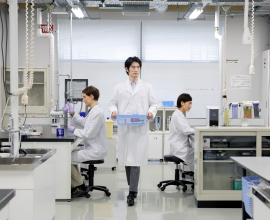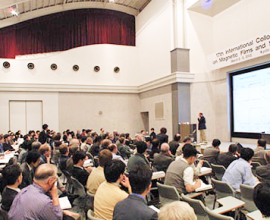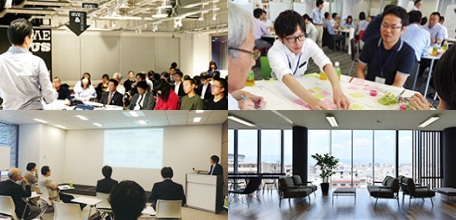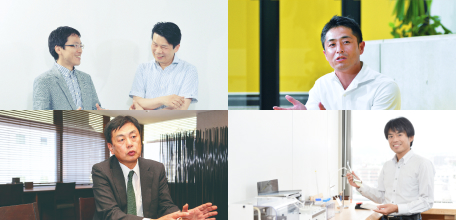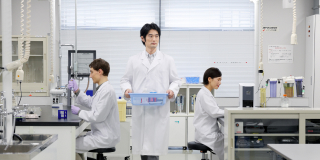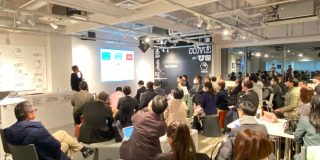2020/11/06(金)
Maria Lamottke, Head of Business Affairs & IR, Project Management, Bicoll GmbH
Patient twin on inflammatory diseases (PTID)
Maria Lamottke, Head of Business Affairs & IR, Project Management, Bicoll GmbH

[Summary]
IDEA AND DEVELOPMENT GOALS
A test for identifying the likelihood of successful compounds will be established and run in parallel of identifying active compounds itself as well as using and applying clinical samples.
END CLIENT IN THE LONG RUN
Physician who is using the patient chip technology able to make individual predictions possible for the best treatment options for patients, and identifying the right compounds for it.
CLIENT=COLLABORATION PARTNER FOR A SHORT RUN
Academic partner with established cell-line models on rheumatoid arthritis for the proof of concept. Pharmaceutical company who is able to do clinical trials with the developed prototype as a part of out-licensing, which allows individual predictions possible for the best treatment options for patients, and identifying the right compounds for it.
SOCIAL IMPACT
Precision medicine means that the each patient get his own treatment with the best drugs, so it decreases patient suffering from disease and non-accurate treatment options, right channeled investment for the treatment from the insurances company, government and patient and improves the efficiency of the therapy.
CURRENT STATUS OF SCIENCE REGARDING PROJECT
Chronic inflammation is a root cause of chronic disease, a growing concern throughout the world, where 80 percent of people 65 and over suffer from at least one condition, such as allergy, atherosclerosis, cancer, arthritis and autoimmune disease i, ii.
Inflammation is body's immediate response to damage to its tissues and cells by pathogens, noxious stimuli such as chemicals, or physical injury. 1 In contrast to an (often physiological) acute inflammatory response, chronic inflammation is a prolonged, dysregulated and maladaptive response that involves active inflammation, tissue destruction and attempts at tissue repair. The identity and characteristics of the, often endogenous, inducers of chronic inflammation are poorly defined and might be accelerate by the lifestyle we have established in the developed world (less physical activities - and wrong food intake for that).2
An inflammatory response, executed by the immune system, is dependent on energy sources, which is controlled by the metabolic system of the human body. There is close bidirectional communication between the immune and metabolic systems that have closely developed through evolution and thus share some important players. E.g. gene expression in both system controlled by the same nuclear receptors (NR).xvi These are proteins that regulate the level transcription of the genes involved in inflammation and metabolism, which can be subsequently enhanced or silenced.xv
The activity of NRs is regulated by binding of a ligand. A wide variety of molecules have been reported to serve as selective ligands for different NRs and bind to the ligand-binding domain (LBD).
Condensed chromatin results in a 'silent' gene, because the proteins of the gene transcription machinery, e.g. RNA polymerase, cannot reach the gene's DNA.
NRs are binding with the regulatory elements of genes for which they control the activity. Often these NRs are in complex with coregulator proteins, which maintain the local chromatin density, i.e. corepressors. Ligand binding alters the NR conformation and decrease the affinity for the associated corepressors, which are subsequently repulsed. Moreover the new NR conformation leads to recruitment of alternative coregulators, i.e coactivators, which open up the chromatin so that the transcription proteins can reach the target gene that is subsequently 'activated'. This process of gene activation by an agonist, a ligand that stimulates the activity of an NR, is reversible, e.g. by an antagonist.
In short, following this mechanism of action (i.e. transactivation) gene activity, the accessibility of a gene's DNA for transcription, is the net summation of coregulators recruited by the local NR, which depends on nature of the ligand.
As an example, liver X receptors (LXR) are NRs and master regulator of metabolism. Sterols and oxysterols are metabolic products and serve as ligand for LXR and thus regulate activity by feedback. Alternatively, LXR also plays an important role in the activity of macrophages, immune cells that play a key role in many inflammatory responses.iii, iv, v NRs with similar dual roles in inflammation and metabolism are PPARsvi.
It is therefore likely to assume this a disturbed metabolism, e.g. caused by aberrant food consumption may, lead to problems at sites where key signaling molecules on both metabolic and inflammatory pathway converge.
The activity of NRs is regulated by ligand binding to a designated binding pocked and thus these proteins are highly drugable. Due to their key role in metabolism and inflammation PPARs and LXRs are therefore important candidates for therapeutic intervention.vii, viii
Genes can have a pro- or anti-inflammatory effect and therapeutic agents, ligands, should aim for inactivation of pro-inflammatory and enhancement of anti-inflammatory genes.
At present, a large variety of coregulators have been described, each with their own functionality and tissue-specific expression pattern. In addition, pro- and anti-inflammatory genes display differential requirement for coregulator recruitment in order to be activated, and thus a successful drug should induce an NR conformation which favors the coregulator recruitment profile that fits a net anti-inflammatory behavior.ix, x
Especially plant secondary metabolites show a great diversity of sterol like types (e.g. terpenoids) which have the highest success rate to base any drug discovery imitative on it.xi
CURRENT STATUS OF DEVELOPMENT
Widely tool to screen for compounds that alter NR activity, reporter gene assays, lack the resolution for selection of such a high level of compound selectivity. The coregulator content of these models is poorly defined, and the compound effect is determined on an artificially constructed gene with regulatory elements with no link to pro- or anti-inflammatory behavior.
In our approach, we use a cell-free platform where all coregulators are available. These are
represented by immobilized peptides representing NR binding motifs, and potential interaction with a target NR in solution can be measured. A compound is classified by its ability to enhance or decrease the interaction between the target NR and each individual coregulator. Compounds in the same class, i.e. that recruit the same set of coregulators, are likely to have similar pharmacology and differential recruitment between classes indicates differential mode of action. Class-representing compounds can subsequently be tested in higher complexity inflammation models to link the appropriate favorable coregulator recruitment profile to the desired therapeutic index. These profiles can also be used for next round compound selection, e.g. for improvement of PK-PD.
Besides LXRs and PPARs a wide variety of NRs have been implicated to play a role in inflammation and each may be a target for therapeutic interventionxii, xiii, xiv. The assay should be applicable for all nuclear receptors, provided a protein formulation is available for testing on our platform.
Selection of the plant collection is based intense collaboration of anti-inflammatory used of plant ingredients described in historical Asian collections and their transfer on the patient-twin technology, including of novel ingredients found in the selected plant species and metabolic potent to synthesize small molecules influencing beneficial the chronically status of patients.
COMMERCIAL OPPORTUNITIES
Chronic inflammation is a cause of many human diseases as described earlier. Many nuclear receptors are involved or driving inflammatory processes such as among others LXR in atherosclerosis, PPAR in rheumatoid arthritis, GR in asthma, FXR in inflammatory bowel diseases and ER and AR in inflammatory breast cancer. The top-3 areas for inflammatory disease are asthma, rheumatoid arthritis and atherosclerotic. These diseases are people worldwide and millions in Japan, alone. The new incidence of asthma in Japan was estimated at 3.4% of the population or
4.2 million3 in 2006. The estimated prevalence of rheumatoid arthritis in Japan was 1.2 million4 of which 79% are treated and 27% of these treated patients are treated with methotrexate. The prevalence of high-risk atherosclerotic cardiovascular disease in 2008-2009 in Japan was 2.3 million5 with a total first-year cost of $8.2 billion.
Currently there are 20 active clinical trials in Japan (569 studies worldwide) involving asthma, 29 active studies in Japan (517 trials worldwide) involving rheumatoid arthritis and 12 active studies in Japan involving atherosclerotic related cardiovascular disease (560 trials worldwide)6
Japan has a number of very active pharmaceutical companies including Astellas, Chugai, Hisamitsu, Mitsubishi Tanabe, Nippon Kayaku, Ono, Otsuka, Rohto, Sankogan, Santen, Shionogi, Sumitomo Dainippon, Taiho, Taisho, Takeda and Teijin. We consider these major Japanese pharmaceutical companies as our pool of strategic licensees to out license our compounds. In total these Japanese companies are currently (December 2017) sponsors in 405 active clinical trials (www.clinicaltrials.gov). These companies have been involved with 11 asthma trials, 60 rheumatoid arthritis trials and 10 involving atherosclerotic related cardiovascular disease trials.
IP STRATEGY
An intellectual property framework will be established with the finalization of the collaboration agreement. This will balance the competing priorities of publication and commercialization. A standard on DESCA model oriented will be customized for this project. The foreground knowledge generated by the project will be reviewed at each plenary meeting (IP will be a "standard item" on the plenary agenda). A strategy for either protection (e.g. via patent) or publication will be agreed. We anticipate that several project outputs will have commercialization potential.
The cooperation agreement will stipulate that the ownership of IP of any output from the project will remain with the partner who developed the output. For any output that is jointly developed between multiple partners, the IP will be jointly-owned and co-ownership agreements will be established.
BACKGROUND COMPETENCE OF COOPERATING PARTNERS
Japanese company with the focus on molecular biology, genetic engineering and immunology. It produces and sells proteins for use in nuclear receptor (NR) research is therefore very interested to use and sell these proteins, the isolation and purification processes and the proprietary cell lines that are used to produce these NR proteins for the discovery of active compounds with a medicinal potential.
Japanese University with the lead of Professor as a leading expert in the field of personalized drug therapy and chemical safety. He has published more than 400 papers and has extensive expertise in the field of nuclear receptor signaling and drug discovery.
Bicoll GmbH is a 20-year old German biopharmaceutical company with it's a wholly owned subsidiary in Shanghai, offering pre-clinical support in the area of drug discovery research from natural products and medicinal chemistry. Dedicated to the discovery and optimization of the highest quality lead compounds, Bicoll provides an efficient, multi-disciplinary approach to drug discovery. With outstanding expertise in high tech natural product chemistry and validated experience in medicinal chemistry, Bicoll increases quality and quantity of the drug discovery pipeline of its partner's candidates' portfolio. Bicoll produces and fractionates plant extracts ("Bicoll plant Profiles™") with the purpose of discovering new active medicinal compounds and is interested to test these fractions for activity on NR proteins. Here identification of anti-cancer compoundsxv as well as nanomolar active compounds for nuclear receptors and general anti-inflammation active small molecules from plantsxvi has been already achieved.
ICL: The Institute for Chinese Life-Science (ICL) has been founded in the year 2006 on an initiative of the Horst-Görtz-foundation. Its main research interests are theory, history and ethics Asian, especially Chinese life science at the Charité-Universitätsmedizin Berlin. A strength of the institute is the research on topics related to understanding on historical recipes-collections and their application on today's research and discovery activities for pharmaceutical ingredients (e.g. for Symrise AG).
-------------------------------------------------------------------------------------------------
1 See for example active small molecules from plants as Bicoll patent: German patent No. 10 2005
027 796: "Verfahren zum Auffinden eines Wirkstoffes, welches ein Abtöten von Tumorzellen bei einer
Tumorerkrankung eines Säugetiers oder Menschen ermöglicht", G. Bauer, K. Lamottke, C. Haug.
2 See the iniative of better food quality of Symrise AG (https://www.symrise.com/company/), the Berlin hospital Charité and
Bicoll: https://bicoll-group.com/simleap-project-reformulation-of-low-calorie-foods/
3 Yuma Fukutomi et al. Allergology International. 2011;60:443-448
4 Yamanaka H1, Sugiyama N, et al. Mod Rheumatol. 2014 Jan;24(1):33-40.
5 Davis KL1 et al. J Atheroscler Thromb. 2015;22(12):1287-304.
6 https://clinicaltrials.gov using the following filters Recruiting, Not yet recruiting, Active, not recruiting, Enrolling by invitation Studies
[Profile]
Maria Lamottke has joined Bicoll in 2010 (and PTID project at the preparation stage in 2016) bringing in the expertise of business development to a fast developing plant natural products and medicinal chemistry company. Thorough project management support and client support have brought a large number of projects to a success: from a small academic group to a big pharma, in the field of pharmaceuticals, nutraceuticals, cosmetics and crop science.





